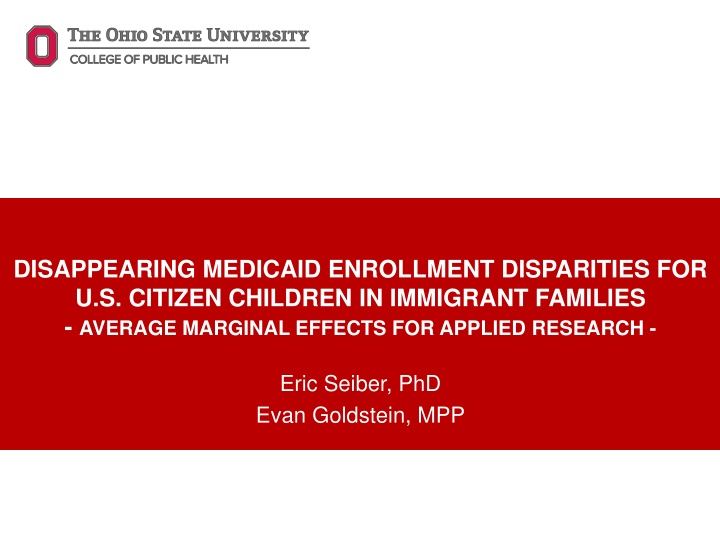
Disparities in Medicaid Enrollment for US Citizen Children in Immigrant Families
Explore the research on disappearing Medicaid enrollment disparities for US citizen children in immigrant families, funded by the Foundation for Child Development. Discover the background of immigrant children, trends in child coverage, and the methodology used in the study to predict the transient nature of coverage gains for Medicaid-eligible children.
Download Presentation

Please find below an Image/Link to download the presentation.
The content on the website is provided AS IS for your information and personal use only. It may not be sold, licensed, or shared on other websites without obtaining consent from the author. If you encounter any issues during the download, it is possible that the publisher has removed the file from their server.
You are allowed to download the files provided on this website for personal or commercial use, subject to the condition that they are used lawfully. All files are the property of their respective owners.
The content on the website is provided AS IS for your information and personal use only. It may not be sold, licensed, or shared on other websites without obtaining consent from the author.
E N D
Presentation Transcript
DISAPPEARING MEDICAID ENROLLMENT DISPARITIES FOR U.S. CITIZEN CHILDREN IN IMMIGRANT FAMILIES - AVERAGE MARGINAL EFFECTS FOR APPLIED RESEARCH - Eric Seiber, PhD Evan Goldstein, MPP
Question? Will coverage gains prove transient for Medicaid eligible children in immigrant families? Partially funded by the Foundation for Child Development
Background Who are the 19 million immigrant children? Non-citizen, first generation immigrants Naturalized, first generation immigrants Native born, at least one immigrant parent Immigrant children in this presentation Groups #2 and #3 Includes 26% of all citizen children (2015) Qualify for Medicaid if income eligible But, parent must enroll them
Trends in Child Coverage National changes mask important state level differences
Methodology 2008-2015 American Community Survey 3 million households per year Sample: 1.7 million Medicaid eligible children Including 443,000 immigrant children Only citizenship status, not documentation Predicting probability of remaining uninsured Sample includes only Medicaid eligible children 5
Methodology Probit model with State fixed effects, State*Immigrant Family interactions Fixed effects: usually imprecise, nuisance parameters Large ACS sample allows increased precision Why might a state have more uninsured children in immigrant families?: Harder for all children to enroll in Medicaid? State fixed effects Harder to enroll for just children in immigrant families? State fixed effects * Immigrant Family interactions Harder immigrant population to enroll? Measures of the immigrant experience
Preliminary Findings State*Immigrant Family Interaction Effects Probability an immigrant child is uninsured in that state, compared to California Five Top States Coef. Std. Error 1. Maine -10.4% 3.1% 2. Oregon -5.9% 2.7% 3. Massachusetts -5.1% 0.9% 4. Michigan -4.1% 2.0% 5. New York -4.0% 0.8% Advancing Knowledge. Improving Life.
Methodology: Average Marginal Effects Example: Estimating Enrollment Disparities: Differentials are the average marginal effects of the State fixed effects * Immigrant Family interactions Predicted Percent Uninsured but Medicaid Eligible Example: Utah 2009 2011 2013 2015 Citizen Children in Immigrant Families 31.5% 29.7% 24.0% 19.8% Citizen Children with Two Native Parents 13.0% 12.3% 10.7% 9.3% Enrollment Differential 18.5% 17.5% 13.3% 10.5% Average Enrollment Differential (all states) 5.2% 3.2% 2.4% 1.9% Median Enrollment Differential (all states) 4.4% 3.1% 2.1% 1.5%
Results 2008 vs 2015 Enrollment Differentials Average reduction of 50%; some states eliminated their enrollment differential.
Results Reductions in enrollment disparities of 50%-100% across almost all states from 2008-2015 Timing of reductions not consistent across states: Many states achieved their gains by 2011.
Results Question: Do the reductions correlate with a particular legislative or policy change? Potential Policy Levers: CHIPRA Medicaid Expansion ACA Adult Medicaid Expansion CHIPRA ICHIA Option CHIPRA Bonus Payments Problems: 1. 2. Few policy changes in states with largest gains Even if a policy change, gains frequently predated the change
2009 States 2015 States Policy Changes from 2008 - 2015 ICHIA option under CHIPRA* 17 28 CHIPRA Medicaid Expansion 0 15 ACA Medicaid Expansion 0 32 CHIPRA Bonus Payments (any year) 26 states - Asset test not required 47 51 - Presumptive eligibility for children 14 15 - No face-to-face interview (enrollment) 48 51 - 12 month continuous eligibility for kids, Mcd 21 18 - 12 month eligibility period (ACA required) 51 44 12
Policy Adoption by States with 10 Largest Reductions CHIPRA Medicaid Expansion ACA Adult Medicaid Expansion CHIPRA ICHIA Option CHIPRA Bonus Payments Joint Mcd/CHIP Application Mississippi No No No No Yes, 2000 Idaho No No No 2010-2013 Yes, 2004 Colorado Yes No Yes Yes Yes, 2015 No 2010-2013 No Yes, 2000 Yes, 2002; No, 2005 Nevada Utah No No No 2012-2013 Yes, 2009 Virginia No No Yes, 2009 2010-2013 Yes, 2000 Ohio No Yes Yes, 2014 2010-2013 N/A Washington Yes Yes Yes, 2009 2009-2013 Yes, 2000 Georgia No No No 2010-2012 Yes, 2000 Florida No No No No Yes, 2000
Summary Reductions in enrollment disparities of 50%-100% across almost all states from 2008-2015. No legislative or policy change corresponds to the improvements Timing matches CHIPRA, but enrollment simplification changes predate by many years. Will these gains prove transient in the current immigration environment? If not policy, is the cause regulatory or operational? If operational, gains may prove ephemeral. 14
DISAPPEARING MEDICAID ENROLLMENT DISPARITIES FOR U.S. CITIZEN CHILDREN IN IMMIGRANT FAMILIES - AVERAGE MARGINAL EFFECTS FOR APPLIED RESEARCH - Eric Seiber, PhD Evan Goldstein, MPP
